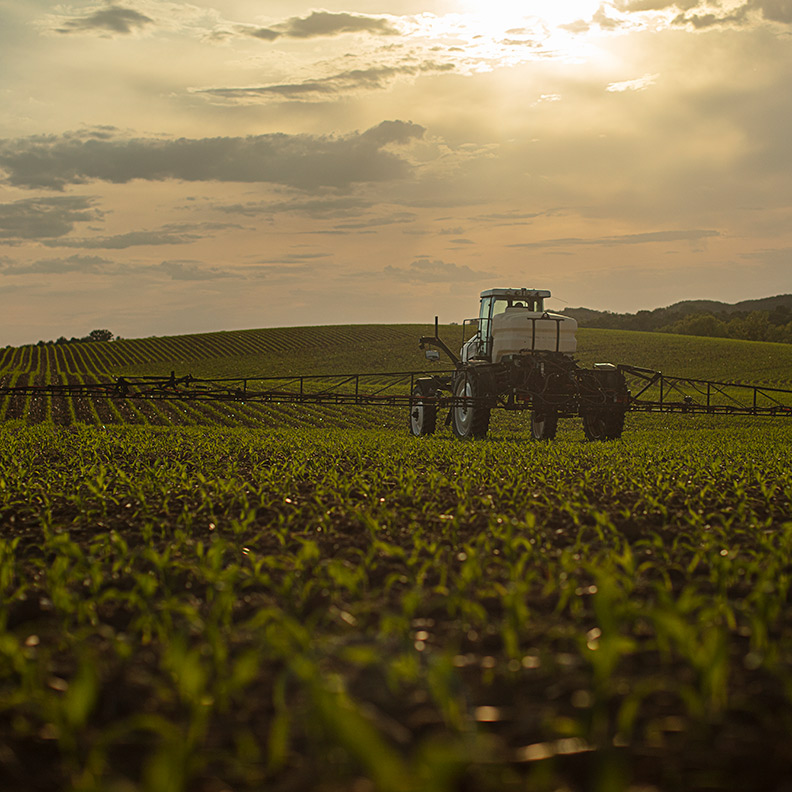Even after a winter that saw heavy snowfall across much of the Midwest, planting is generally progressing at a good pace. U.S. farmers are expected to plant 92 million acres of corn, up 4% year-over-year, and 87.5 million acres of soybeans this year1. This would be the fourth highest amount of corn in the last 10 years and second highest amount of soybeans.
Despite the good pace of planting so far, ag operators are also keeping a close eye on prevented planting dates, which span from May 25 to May 31 for corn in the northern Cornbelt. Crops that are planted after those dates lose a portion of insurance coverage, otherwise a field can be claimed for prevented planting and receive an insurance payment. Any planting delays in North Dakota or northern Minnesota may increase concerns of prevented planting claims.
U.S. row crops
As of mid-May, 81% of the U.S. corn crop has been planted, compared to the five-year average of 75%. Soybeans are at 66% (52% five-year average) and spring wheat is 64% planted (73% five-year average). The strong figures have come despite some localized areas of heavy rainfall over 10 inches in Minnesota and northern Iowa that has presented challenges to farmers.
The USDA estimates the corn stocks-to-use ratio at 15.34%, or a 56-day supply. Soybeans are at 7.58%, or a 28-day supply.
December corn futures are down 16.4% since the beginning of the year and are now at $5.09 per bushel. Weakened global demand and market prices, along with China cancelling U.S. corn orders in April and May, have contributed to the decline. For the first time since late-2020, corn has a net-short managed money position.
Meanwhile, soybeans are down 15.3% at $11.97 per bushel, and wheat is down 22.0% in 2023 and sits at $6.36 per bushel. The Wheat Quality Council crop tour in Kansas estimated a dismal 30.0 bushels per acre wheat yield, which is well behind the historical five-year average of 44.8. It is estimated that nearly 19% of planted acres will not be harvested due to poor crop conditions from the drought. Kansas planted over 20% more wheat than any other state in 2023.
U.S. livestock and dairy
All dairy and livestock producers are seeing a decrease in feed costs due to bearish trends in the grain and oilseed markets. The May feeder cattle contract is at approximately $206, off from a high of $212.75 in late April but up 7% since January 1.
July 2023 Class III milk prices are down 14.6% since January 1. The U.S. exported 91.6 million pounds of cheese in March, which was the second highest March ever, primarily due to a strong Mexican peso, according to the USDA.
Local ag outlooks
Josh Mattson, Ag Banker, Rugby, ND
“Spring seemed to take its time to show up, but most farmers are seeing favorable seeding conditions, especially on last year’s soybean and canola ground. With a warm and dry extended forecast, most farmers could see ideal seeding conditions. In fact, the Rugby area could even use some rain.
“If area farmers are able to get all the crop seeded, it should be another great year for farmers in the area.”
Al Uetz, Ag Banker, Moorhead, MN
“A cool and wet spring delayed planting activity. Farmers started with wheat and sugarbeet acres, so most will have those acres planted soon. Corn and soybean producers waited for the ground to warm up so they’re all working on those acres now.
“With predictions of farm income dropping in 2023 due to decreased commodity prices, input costs and interest rates remaining high, farmers really need to know their cost of production and use that knowledge in their marketing plan to lock in profits for 2023. Input costs are ‘sticky’ for farmers — commodity prices tend to correct quickly while input costs often stay high after they’ve increased.
“Because many farmers realized strong farm income results over multiple years, they have very strong balance sheets, which will help to weather some adversity. Locally, 2022 started with a late, wet spring but growing conditions were favorable, and farmers produced average to above average crop yields. Many farmers want to keep their liquidity — it felt good to pay off some debt and still have some excess cash flow in their accounts.”
Global agriculture
In Ukraine, the Black Sea export pact expired May 18 but was ultimately extended another two months2. However, some neighboring countries are working to extend a ban on the imports of Ukrainian crops due to these imports hurting domestic crop prices3.
Ukrainian corn production is estimated at 21.1 million metric tons by the Ukrainian Grain Association, which is 22.7% lower than last year due to farmers planting less because corn is more expensive to grow, dry and transport than other crops. Sunflower production is estimated to be 20% higher than last year but still 25% below pre-war levels.
In Brazil, sugar mills are producing as much sugar as possible versus sugar-cane-based ethanol due to the highest price difference in the last 12 years4. The Brazilian government is abolishing its fuel import parity policy, and state-controlled Petrobras will decrease fuel prices by 12%, which will further apply downward pressure on ethanol prices. Brazil also detected its first case of avian flu in May, which may be the start of a supply issue for the largest chicken exporter in the world.
What to watch for
Weather will be key in the months ahead. The long and snowy winter in parts of the U.S. presented some challenges, but so long as weather remains favorable throughout the finish of planting season and into critical crop growth stages, farmers should be in a good position. However, some prevented planting will occur in certain locations.
Outside of macroeconomic demand factors, potential supply issues including avian flu outbreaks and U.S. commodity prices relative to other countries may quickly alter markets.

